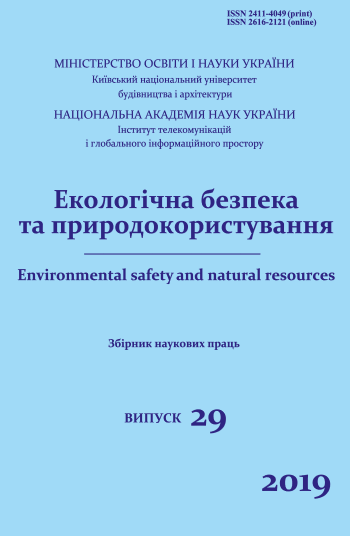Situational predictive modelling of the flood hazard in the Dniester river valley near the town of Halych
DOI:
https://doi.org/10.32347/2411-4049.2019.1.16-27Keywords:
ambiguity, data, the Dniester River, flood hazard, hydrological observations, situational model, situational predictive modellingAbstract
There has been presented a method of situational predictive modelling of the flood hazard in the Dniester River valley near the town of Halych based of hydrological observations data obtained at the Halych water level gauge. Some features in the behaviour of the equation of relationship between levels and water discharges for the Halych water level gauge were revealed, in particularly, regularities fostering reliable forecasting the flood hazard by means of statistical data and ambiguities interfering similar predicting. The possibility of effective situational predicting of the flood hazard according to current data of hydrological observations to minimize probable harm and losses was shown.References
Abbott, P. L. (1996). Natural Disasters. Wm. C. Brown Publishing Co.
Doocy, S., Daniels, A., Murray, S., & Kirsch, T. D. (2013). The Human Impact of Floods: A Historical Review of Events 1980-2009 and Systematic Literature Review. PLoS Currents. doi:10.1371/currents.dis.f4deb457904936b07c09daa98ee8171a
Dobrovičová, S., Dobrovič, R., & Dobrovič, J. (2015). The Economic impact of floods and their importance in different Regions of the World with Emphasis on Europe. In Business Economics and Management 2015 Conference, BEM2015 (pp. 649-655).
Kundzewicz, Z. W., Ulbrich, U. et al. (2005). Summer Floods in Central Europe – Climate Change Track? Natural Hazards, 36(1-2), 165-189.
Rufat, S., Tate, E., Burton, Ch. G., & Maroof, A. Say. (2015). Social vulnerability to floods: Review of case studies and implications for measurement. International Journal of Disaster Risk Reduction, (14), 470-486.
Shulyarenko, A., Yatsyuk, M., & Shularenko, I. (n.d.). Causes and peculiarities of recent floods on the Dniester River (J. Marsalek, Ed.). In Flood Issues in Contemporary Water Management (Vol. 71, NATO Science Series 2. Environmental Security, pp. 95-100).
OSCE/UNECE Project. (2005). Transboundary diagnostic study for the Dniester River basin. Retrieved from https://www.osce.org/ukraine/104057?download=true.
Pylypovych, O., & Kovslchuk, І. (2017). Geoecology of the Upper Dniester river-basin system. Lviv, Kyiv: LNU of Ivan Franko (in Ukrainian).
Russell, S. J., & Norvig, P. (2010). Artificial Intelligence: A Modern Approach (3rd ed.). New Jersey: Pearson Education: Upper Saddle River.
Reiter, R. (2001). Knowledge in Action: Logical Foundations for Specifying and Implementing Dynamical Systems. MIT Press.
McCarthy, J. (1963). Situations, actions, and causal laws. Memo 2: Stanford University Artificial Intelligence Project. Retrieved from http://www.dtic.mil/dtic/tr/fulltext/ u2/785031.pdf.
Stefanyshyn, D. V. (2013). A method of forecasting of indexes of dynamic system that evolves slowly, based on time series analysis. In 4th Int. Conf. on Inductive Modelling (pp. 221-224). Kyiv, Ukraine.
Stefanyshyn, D. V. (2017). Improving diagnostic models for forecasting the behavior of dams equipped with automated monitoring systems. Mathematical modeling in economy, (3-4), 50-61.
Kuhn, M., & Johnson, K. (2013). Applied Predictive Modeling. New York: Springer Science+Business Media.
Geisser, S. (2016). Predictive Inference: An Introduction. New York: Chapman & Hall.
Brockwell, P. J., & Davis, R. A. (1991). Time series: Theory and methods (2nd ed.). Springer.
Hamilton, J. D. (1994). Time series analysis. Princeton, New Jersey: Princeton University Press.
Viessman, W. (Ed.). (1975). Introduction to hydrology (1st ed.). New York, London: Intext educational publishers.
Extreme Hydrological Events: New Concepts for Security (1st ed., Vol. IV: Earth and Environmental Sciences, Nato Science Series). (2007). Retrieved from https://link.springer.com/book/10.1007/978-1-4020-5741-0
Koutsoyiannis, D. (2008). Probability and statistics for geophysical processes. Athens: National Technical University of Athens. Retrieved from https://www.itia.ntua.gr/en/docinfo/1322/.
Stefanyshyn, D. V. (2018). On the use of the type I Gumbel distribution to assess risks given floods. Mathematical modeling in economy, (1), 74-83.
Taleb, N. N. (2010). The Black Swan. The Impact of the Highly Improbable (2nd enlarged ed.). New York: Random House.
Kirshners, A., & Borisov, A. A. (2012). Comparative Analysis of Short Time Series Processing Methods. Information Technology and Management Science, (15), 65-69.
Trofymchuk, O., Kaliukh, I., & Klimenkov, O. (2018). TXT-tool 2.380-1.1: Monitoring and Early Warning System of the Building Constructions of the Livadia Palace, Ukraine. In Landslide Dynamics: ISDR-ICL Landslide Interactive Teaching Tools (pp. 491-508).
Downloads
Published
How to Cite
Issue
Section
License
Copyright (c) 2019 Dmytro V. Stefanyshyn, Vasyl M. Korbutiak, Yulija D. Stefanyshyna-Gavryliuk

This work is licensed under a Creative Commons Attribution 4.0 International License.
The journal «Environmental safety and natural resources» works under Creative Commons Attribution 4.0 International (CC BY 4.0).
The licensing policy is compatible with the overwhelming majority of open access and archiving policies.

